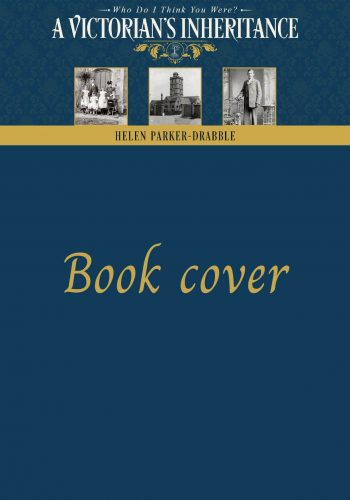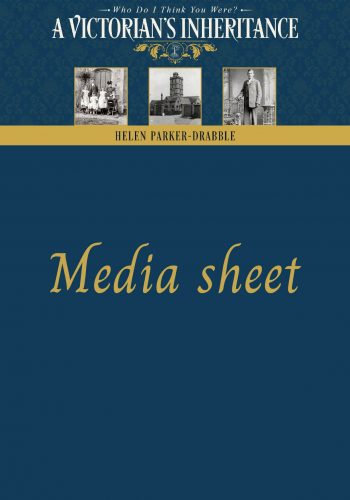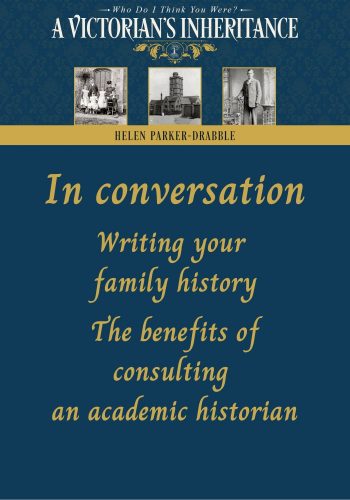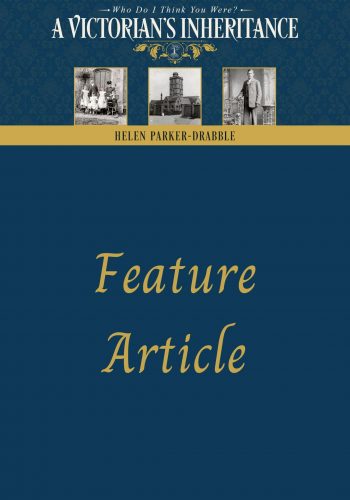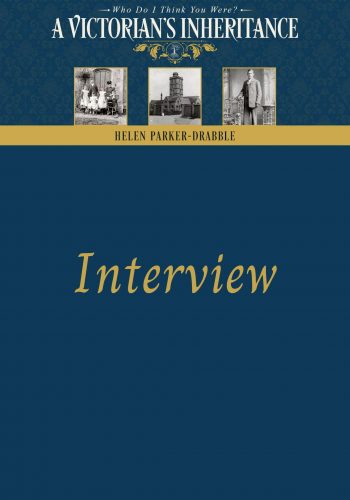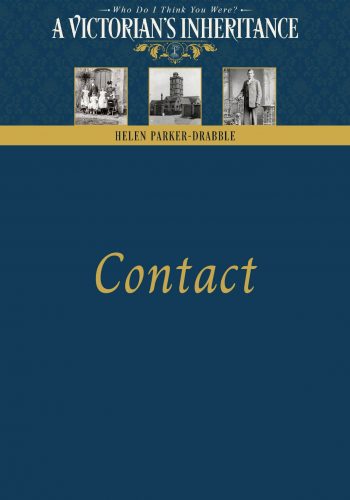Media
Welcome to the media resources. Here’s where you’ll find more about the book ‘Who Do I Think You Were?’ A Victorian’s Inheritance, including images.
Can’t find what you’re looking for? Contact me.

Interview with geneatherapist Helen Parker-Drabble
‘Geneatherapy’ is the word I feel best reflects what I aim to achieve with my writing. It combines two of my greatest passions: I’m a counsellor by profession and a genealogist and family historian by experience. According to the online Cambridge dictionary one of the definitions of therapy is it is a ‘treatment that helps someone feel better or grow stronger’. So as a geneatherapist, I explore mental health, psychology, and neuroscience, to deepen my understanding of our ancestors, which in turn can benefit the present and future generations.
It was the book I most wanted to read. When I was eleven, my grandfather came to live with us. I thought this would be my chance to hear all about his Victorian childhood and his adventures on the Canadian Prairies, but he was emotionally distant and kept his story largely to himself. I desperately wanted to know him, but I had to find another way to unearth his story.
My mum told me her father was a ‘Victorian fossil’, a distant parent she could never get close to. So, I set out to find what had stopped him from being an open, loving parent and grandparent. What had affected him most: Victorian values, Victorian English village life or his alcoholic mother? This became the bones of the story I decided to tell.
I’d done the genealogical research, walked in my grandfather’s footsteps and immersed myself in social history, but if I wanted a deeper understanding of the man, I was asking the wrong questions. Granddad was once a child, like any of us, and I needed to look at what this Victorian boy had inherited from his ancestors. When I explored the life of his parents and grandparents a psychological inheritance unravelled, revealing intergenerational anxiety, trauma, loss, alcoholism, and depression. I think no family tree is without these.
Psychological inheritance refers to the inherited traits, reactions, patterns of behaviour and our take on life, which are passed down through the generations and persist over time. We carry them with us, from situation to situation.
It can be something positive or negative. For example, they might have inherited patterns of anger, trauma, cruelty, avoidance, violence, fear or dissociation. On the other hand an ancestor might be endowed with optimism, gratitude, a love of nature, resilience, intelligence, self-esteem, talent, kindness, a spirit for adventure, humour, the ability to forgive and the capacity to love. This is what is meant by ‘epigenetics’ – the idea that our lived experience can affect our children and grandchildren. It’s sobering to think physiological and psychological trauma can affect not only the person involved but also successive generations. Ancestral trauma can even influence and shape a descendant who has no knowledge of it. All these ideas helped me think about what Walter may have inherited – and what may have been passed down to me and my descendants.
That neuroscience explains how our ancestors’ unique experiences, diet, and even their geographical location help construct the architecture of our brain. Genealogically speaking, the experiences of our grandparents and parents influence our own development. Cultural and family values are also transmitted through our families of origin, which in turn have their roots in past generations. And, because our psychological and biological characteristics are profoundly affected by the contexts in which we grow up, what happens to grandparents reverberates through the ages to affect their descendants.
Walter’s mother Ann was four when she lost her mother to consumption. Modern research shows us that a quarter of children develop serious psychological issues following a parent’s death.[i] It seems a forlorn hope that Ann’s environment was more protective than in recent times. By the time Ann married, only four of her nine full siblings were still alive. Her firstborn then died a slow, painful death at only 18 months old. It would make sense if these experiences affected her. Perhaps it explains her addiction to alcohol. She may have been self-soothing a depression born from her catastrophic losses. She might have found it difficult to bond with her children, fearful that they too would be taken from her. Walter may have learnt to keep himself emotionally contained, growing up with an alcoholic mother; and as I mentioned, this impacted his daughter – my mother.
Worden, J. and Silverman, P. (1996). ‘Parental death and the adjustment of school-age children’. OMEGA – Journal of Death and Dying, 33(2), pp. 91–102.
Two reasons: first, a lot of family historians try to make sense of a relative. The psychological theories I use to understand my grandfather could help others think differently about their own families. The second reason is that I looked for examples of family history writing and found very little. I hope this book motivates and encourages people interested in their family history to pass on what they have painstakingly uncovered, to pass on a record to future generations. Because research shows that children who have the most self-confidence have a strong ‘intergenerational self’. They know they belong to something bigger than themselves. Above all, sharing stories has a powerful impact on all family members, especially on adolescent identity and well-being.
There has never been more opportunity to challenge and reflect on the way we live our lives. More people than ever are struggling with anxiety, addiction, and depression. Many are looking at what they can do to improve their own and others’ health and live positively. Mental health is finally being talked about and there’s an enormous amount of research being published from nutrition and its effect on mood, to how trauma can be reversed. New understanding and the tools to implement it can help us live well and leave a healthier legacy.
Family history can be a powerful antidote against adverse life experiences. It builds resilience. All of us have ancestors who overcame disaster and survived tough times. Learning their stories helps us to see we too can survive. I hope A Victorian’s Inheritance shows how developing an understanding of why people may behave as they do could promote self-awareness and encourage families to break cycles of abuse or misery. By looking at the past people may discover they’re more resilient than they know. Our forebears survived war, poverty, trauma, and pandemics. So can we.
Absolutely, and without concentrating on my grandfather’s dogged persistence, his resilience, and his inability to give up, I may never have finished it! I would encourage all family historians to put what they know in print, especially the stories. It’s the only way family history survives. It could be a photo book with captions, a journal or diary, mini-biographies, scrapbooking – anything that can be passed down the family line.
The Internet gives armchair genealogists access to a vast number of records. Generous, passionate professionals provide tips to structure research, how to prove online records are accurate (or not) and ways to overcome brick walls. If you want to put flesh on the bones, nothing beats walking the streets of your ancestors. Google Earth can give you a flavour if you can’t visit in person. There are also many online archival records you can immerse yourself in. I was fortunate enough to complete the research before coronavirus forced archives to close. You may even get lucky and find living family who can help you fill in some blanks.
For an historical overview of the book, I consulted an academic historian, Dr George Regkouko. George was enormously encouraging and validating, and was able to point me in directions I hadn’t considered.
To go deeper in my understanding, I turned to psychological theories of human development, identity, and social behaviour. I extended my understanding of neuroscience and neuropsychology: the crossover between science and psychology. This led me to epigenetics, the study of nature (our genes) and nurture (our environment). Epigenetics seeks to explain how our environment and life experiences trigger on-off mechanisms in our genes, which can affect us and our descendants, physically and psychologically.
This is the first book of three. All will include psychological theory and research to show the impact Walter’s experiences might have had on him. The next book takes Walter to Canada, where I look at the psychology of migration and the emotional costs and rewards of starting a new life far from where one was raised. I explore homesteading from the bachelor point of view, World War 1, and how Walter kept in touch with family and life in Thorney village.
They can visit:
- helenparkerdrabble.com and read the first two chapters for free (this includes the index and endnotes of these chapters)
- Read articles here: https://www.helenparkerdrabble.com/blog/
- To buyWho Do I Think You Were?® A Victorian’s Inheritance: https://geni.us/6SNCT5.
Who Do I Think You Were?
Many of us know that learning about our ancestors’ lives can help us understand ourselves. But did you know that understanding your ancestors can also directly impact you and your family?
We know that one in four of us will suffer with a mental health disorder at some point in our lives, making them one of the leading causes of disability worldwide. Family historians are well placed to have an important role in the fight against ill mental health.
• Family history can be a powerful antidote against adverse life experiences. It helps us build resilience by showing us how we can overcome disaster and survive tough times.
• Children with a strong ‘intergenerational sense’ are more self-confident.
• Sharing stories has a positive impact on all family members, especially on adolescent identity and well-being.
• Family histories can help determine, and challenge, the effect of inheritance on mental health.
Ultimately though Helen’s book is about hope, perseverance, and strength. For it is not only inherited patterns of anger, trauma, cruelty, avoidance, violence, fear or dissociation that can be passed on. An ancestor might be endowed with optimism, gratitude, a love of nature, resilience, intelligence, self-esteems, talent, kindness, a spirit for adventure, humour, the ability to forgive and the capacity to love. By considering the inherited traits, reactions, patterns of behaviour and our ancestors take on life we can reflect on what might have been inherited and honour those who came before.
The good news is our psychological inheritance need not define how we live out our lives. Whatever our starting point we can live positively, thrive, and pass on a different legacy.
***
Other articles available from https://www.helenparkerdrabble.com/blog/
Helen Parker-Drabble is a former counsellor, a genealogist, and a family historian. She now describes herself as a ‘geneatherapist’ who explores mental health, mental illness, and psychology through different eras, in the hope that by exploring what impacted our ancestors we help the present generation and those to come.
For more visit:
- helenparkerdrabble.com and read the first two chapters for free (includes references, index, and endnotes). Just scroll down to the bottom of the page and click on the button ‘Your two FREE chapters are waiting’.
- Support an independent author and buy all formats from https://www.helenparkerdrabble.com/shop-a-victorians-inheritance/, order from your favourite book shop, or order online from your choice of store here: https://geni.us/6SNCT5
In conversation
Writing your family history?
The benefits of consulting an academic historian
With academic Dr George Regoukos and family historian Helen Parker-Drabble

George: It’s good to be here.
George: Yes, it was my first experience of working with a family historian. I’d not had access to a private working-class family’s papers before. It was intriguing.
George: I think after that you asked me about how you should confirm citations for a book.
George: The idea of a Victorian’s inheritance written by a family historian piqued my interest, and I asked if you would mind me reading the manuscript.
George: Was it hard to share?
George: That was in midsummer, and by October I was giving you feedback on your penultimate draft.
George: You were astonished I had nothing damning to say!
George: I remember you had discounted some family stories and were amazed when I said whether factually accurate throughout or not, they are part of your family’s story.
George: In fact, what I needed to show you was that you could use oral and social history approaches. It also meant you thought more radically about the nature of ‘truth’ and what matters in history – getting at ‘facts’ or understanding meaning, subjectivities and emotions in the past.
George: That brings us to book two. I know you’re calling it A Victorian Migrates, but when will we discuss your plan for that?
George: Absolutely. I have developed a keen interest in family history projects.
Helen: Thanks for helping me crystalise how much you brought to my writing. Family history is apparently the second-most popular pastime (after gardening). I can see so much potential in bringing together academics working on any given topic and family historians who might just be researching similar themes. It feels good to value the expertise within families and communities as much as within the academic world.
Quotes from A Victorian’s Inheritance
(Some with images)
Why look at ancestors through a psychological lens ?
Understanding psychological inheritance can illuminate our ancestors, but it can also give us the language to consider our own thoughts, beliefs, and behaviour. It can add to the narrative we construct in order to make sense of ourselves and our family.
Our psychological and biological characteristics are profoundly affected by the contexts in which we grow up, what happens to our grandparents reverberates through the ages to affect their descendants.
Our psychological inheritance need not define how we lead our lives. We can become more aware, live positively in our communities, thrive, and pass on a different legacy.
Mental Health
Psychiatrist Myrna Weissman’s thirty-year study covering three generations concluded that 59 per cent of grandchildren who had two generations of major depression preceding them had either depression or an anxiety disorder.
Emotions not explained by the individual’s own experiences may stand for the intergenerational transmission of unresolved loss, conflict or trauma unwittingly passed on as a psychological inheritance.
The price paid by the children of traumatised parents can be confusing as they can struggle with debilitating depression, unexplained grief, and an increased vulnerability to stress, without understanding the cause.
A parent who has unresolved loss can become dissociative and display ‘a range of perplexing behaviours during parenting, including dissociative-like stilling, distorted and frightening facial and vocal expressions and poorly timed, rough or intrusive caregiving’.
Studies repeatedly show that close relationships play a vital part in our personal happiness, health, and general wellbeing.
While there is a genetic connection to psychological states, genes predict behaviour; they do not determine it. The good news is that even without psychological intervention, positive development can continue throughout our lives, so early experiences need not dictate our destiny; there is always the hope that other factors in our present environments can steer us in a new direction.
Medical
In the second half of the nineteenth century, treatments at the Bristol Lunatic Asylum included the surgical removal of the clitoris and the labia and a hysterectomy in pauper inmates.
During the Victorian period infectious diseases killed. The most dangerous illnesses in terms of the number of children who died following infection were tuberculosis, diarrhoea and dysentery, whooping cough, measles, scarlet fever, typhoid, diphtheria, and smallpox.
The school logs detail a cycle of typhus and typhoid, cholera, smallpox, measles, whooping cough, and scarlet fever. These epidemics were as much part of the yearly calendar as Garland Day and the Peterborough Fair.
With few effective treatments, the schools were regularly closed in the hope of reducing the number of people subsequently infected. For example, 17 July 1893, six cases of scarlet fever. Winter brought diphtheria, alongside the usual colds. The school closing for five weeks was not uncommon. (See Photo Gallery for image 01 Example School closed epidemic 1913.)
Bovine TB
In Victorian England drinking milk was akin to Russian roulette: although those with a compromised immune system were more vulnerable, it was impossible to know which children would become infected by bovine tuberculosis until it was too late. Shockingly, the British government did not impose a workable system through which bovine TB could be eradicated until the 1950s. It was a preventable tragedy that infected cows would pass the infection to generations of children well into the middle of the twentieth century. For each person who died of bovine TB, seven to ten people lived with the lifelong emotional scars and physical consequences of the infection in their bones and joints.
Education
Working-class children up to the age of fourteen, were taught reading, writing and arithmetic competency, alongside acceptance of the teacher’s authority and the need for punctuality and conformity.
Education was seen as little more than preparation for future adult work and as a means of teaching the required social character – habits of regularity, ‘self-discipline’, obedience, and trained effort.
Children were examined according to one of six ‘standards’ in reading, writing and arithmetic. Teachers were expected to get as many children through the exams as possible and, as the educationalist and historian Brian Simon said, ‘the most effective way of doing this, especially with very large classes, was by rote learning and drilling’.
An example of Standard III:
Compound Subtraction
£ s. d.
20,710 14 2½
4,983 17 3¾
_______________________________
15,726 16 7¾
When you have finished each sum add the number you have subtracted and the remainder together; if your sum is right; the total of these two is the top line of the sum. It is not necessary to do this with pen or pencil; just run it over in your mind, noticing whether it is right or not as you go along.
In 1892 materials costing £2-1s-5d [£328] were bought by the school. The work produced was sold to support it. The girls sold items to the value of £17-10s-5d [£2,300], while the efforts of the infant girls raised a further £3-9s-5d [£520]. The ‘sales-of-work’ raised enough to pay Miss Annie Crabb, head teacher of the infant and girls’ school, her annual salary of £17-10s [£2,293].
All children attending school were expected to be able to write letters in a clear, legible hand by the time they left.
Social History
Many enterprising boys also shovelled horse manure from the roads, to enrich the earth used for food production or to sell. Children also collected snails, sow thistle, dandelion and choice grass to supplement the barley meal and pot-liquor made of boiled potato peelings and vegetable trimmings to be fed to their pig.
Victorian children knew they were contributing something significant to their home life. They were not talking or playing a game about living; they were experiencing it.
Working-class Victorian women made their own health remedies, cleaning products and alcoholic drinks to consume at home. (See Photo Gallery 02 Parker Family Recipe for Furniture polish)
Before the National Insurance Act of 1911 and the establishment of the welfare state in 1945, friendly societies insured workers against loss of work through bad weather, ill health, accident, or death. The Foresters were such a society, providing sickness, travelling and funeral benefits. Members’ widows and orphans were provided for if the wage earner had paid in. In this way, those who could afford it did their utmost to keep their families out of the workhouse should they, as breadwinner, become incapacitated or die. (See Photo Gallery 03 Ancient Order of Foresters sashes)
In 1898 the mayor of Peterborough, at a meeting to float a new building society, extolled the virtues of financial planning to all working men:
[Some men] persistently fool their money away without having first endeavoured to make some provision for the future… He urged every young working man to religiously put something by before he gratified every little whim and fancy.
Marriage was more of a practical affair than a romantic one. A working-class couple needed to work hard as a team to bring in enough of an income, raise children and manage household affairs.
In the absence of a universal state pension, it was not unusual for children to support their parents financially. Even if the parent received parish relief, it was customary to recoup as much of this as possible from adult working children.
Reading novels was apparently a suitable pursuit for women, ‘and for many cribbed, cabined, and confined as their lives are, with so little outlet for their emotions, they are a wholesome necessity’.
Music and Dance
Skating
Although speed-skating was practised in other parts of the country, fenmen, with their unique style and combination of stamina and speed, were the acknowledged masters. Lancashire sent three of their top skaters to the Swavesey match in January 1879. On the day, George ‘Fish’ Smart was found to be the ‘best man’. His reward was a badge, a sash, and a cash prize. To stop the champion binge drinking, the committee decided to hand the money over in instalments. (See Photo Gallery 04 English speed skates, c. 1890. Photograph by the Marsden Brothers from the Virtual Ice Skates Museum)
Cycling
The Worcester Journal of 1896 warned of the dangers of cycling:
Bicycles are responsible for many things in our social life. A doctor has [described] the bicycle face. Anxious, weary worn, haggard looks are due to the bicycle. So much anxiety is developed in learning to ride, and afterwards in avoiding accidents that it…affects the muscles of the face, and the care worn expression is retained during the other hours of life. At least the doctor – an M.D. London – says so, and he ought to know.
Alcoholism
‘Alcohol consumption was a waste of money, a waste of potential labour, and a waste of the maternal gifts that a woman ‘naturally’ possessed. The body of the female alcoholic was, then, by definition, wasted’.
Alcoholism, particularly in women, was at times thought of and treated as a form of madness or moral insanity, defined as ‘deviance from socially accepted behaviour’.
Epigenetics and DNA
Early-life environmental conditions can cause epigenetic changes in humans that persist throughout life’ leading to increased risk of schizophrenia, coronary heart disease, obesity, and Type 2 diabetes.
Professor of Psychology David Moore adds that DNA does not solely dictate our fate, ‘what we do matters, and that the environments we occupy profoundly influence how we end up’.
Researchers from the University of Zurich and ETH Zurich have discovered that ‘Not only trauma but also the reversal of trauma is inherited’.




